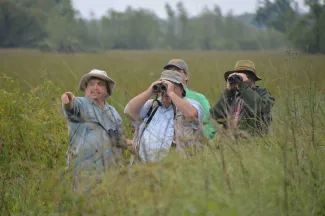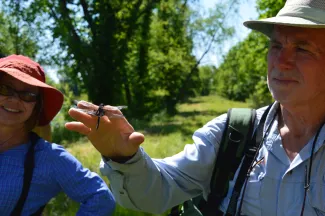Surrounded by dirt roads and towering trees, Red Slough WMA may be off the beaten path, but it’s certainly not off the outdoor enthusiast’s radar. Bird watchers, hunters, anglers and nature photographers from 42 states and 10 countries have been making the trek to this southeastern Oklahoma WMA for years.
“Red Slough is just a fantastic spot,” said David Arbour, biologist aide for the Oklahoma Department of Wildlife Conservation. “More than 300 species of birds, just under 100 species of butterflies, and dozens of reptiles and amphibians have been documented using the area.”
These sizable lists not only indicate the area’s significance to wildlife, but also represent years of work by many conservation partners.
Once one of Oklahoma’s largest wetland complexes, this unique area was drained in the 1960s and converted to farmland, altering the natural flooding cycle along the way. Instead of producing thousands of birds and other wildlife each year, the land produced rice, soybeans, corn and milo.

After 30 years of farming the land, the property owner voluntarily enrolled the area in a federal program designed to protect, restore and enhance wetlands. A year later, a portion of the property was purchased by The Conservation Fund and donated to the Ouachita National Forest to manage for the public. Additional land donations were made in 2000 and 2004, bringing the conservation area to 5,814 acres.
The U.S. Forest Service along with the Natural Resource Conservation Service, the Oklahoma Department of Wildlife Conservation and Ducks Unlimited have since worked to achieve the greatest wetland functions and values, along with high-quality wildlife habitat, on the management area’s every acre.
For the Birds and the Pursuit of Birds
The staggering number of birds – representing 70 percent of all the bird species documented in Oklahoma – is one obvious result of the years spent restoring Red Slough into a functional wetland. Maintaining a variety of habitats, from frequently flooded wetlands to grasslands and forested areas, has greatly enhanced the area’s bird life. Wading birds can stalk fish and crustaceans in the deeper wetlands, shorebirds can actively explore mudflats for prey, and colorful songbirds can rifle through the nearby trees or fields while hunting insects.
The chance to see these birds has not been wasted; bird watchers descend on the area year-round to chase migrating warblers from tree to tree, tally wading birds as they feed in the wetlands, or to get a glimpse of birds typically restricted to the Gulf Coast. Bird watching intensifies each May, when bird migration is in full swing, as visitors across the nation arrive for the Red Slough Birding Convention. Convention participants often rake in sightings of 100 or more bird species and are able to add new species to the list of birds they have seen in their lifetime.

Red Slough’s ability to attract and hold large numbers of mallards, gadwalls and teal has also attracted the attention of waterfowl hunters. The area’s flooded wetlands and premier duck foraging areas draws hunters from Oklahoma, Texas, Louisiana, Arkansas and beyond.
Something to Buzz About
The same variety of habitat that attracts birds to Red Slough also attracts a number of other wildlife including crawfish frogs, western mudsnakes and even American alligators. But something much smaller has created a buzz in certain circles.
“If McCurtain County were a state, it would be ranked 26th in terms of dragonfly diversity,” said Brenda Smith-Patten, conservation biologist with the Oklahoma Biological Survey. “And 82 percent of McCurtain County’s diversity has been documented at Red Slough WMA.”

At least 87 dragonfly species have been recorded on the management area. Red Slough has produced five records for Oklahoma: the duckweed firetail, regal darner, two-striped forceptail, hyacinth glider and evening skimmer were all first spotted on the area.
As adults, dragonflies spend most of their time on the wing. While airborne, they hunt and capture insects, especially mosquitoes; pursue mates; and even lay eggs in flight. In contrast to these aerial adults, immature dragonflies, or nymphs, are fully aquatic. Though waterbound, these nymphs are equally as predatory as adults, preferring a lie-and-wait hunting style.
“Red Slough is a veritable magical wonderland for dragonflies and critters of all sorts,” Smith-Patten said.
Two decades after being set aside to conserve wetland habitat, Red Slough WMA has been transformed from a working rice farm into a magnet for wildlife and visitors alike. Whether pursuing birds, dragonflies, or any of the other species that live at Red Slough, this incredible WMA is worth a visit. Plan your visit at wildlifedepartment.com or fs.usda.gov.